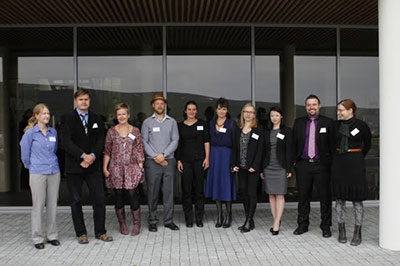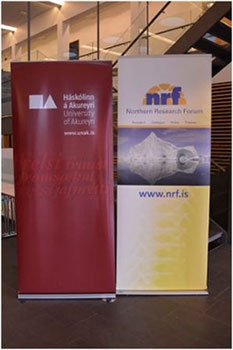The Northern Research Forum (NRF) organizes Open Assemblies biennially for providing a forum for open dialogue between academics, decision-makers and other Arctic or Northern actors and stakeholders on the changes that the Circumpolar North is facing now and in the future. The theme of this 7th Open Assembly that took place in Akureyri, North Iceland in 21-24 August 2013 was “Climate Change in Northern Territories - Sharing Experiences, Exploring New Methods and Assessing Socio-Economic Impacts”. The theme was further divided into three sub-themes: “Territorial socio–economic impacts of climate change”, “Methodologies for assessing socio-economic impact” and “Adaptation to climate change in regions and local communities – examining methods and sharing knowledge”. The conference was organized in collaboration between the Northern Research Forum and ESPON ENECON.
 The Northern Political Economy (NPE) team and the Arctic Centre were strongly represented in the event. Altogether three researchers from the Arctic Centre were chosen to attend the Open Assembly as Young Researchers (YRs): Nicholas Sellheim, Hanna Lempinen and Ilona Mettiäinen.
The Northern Political Economy (NPE) team and the Arctic Centre were strongly represented in the event. Altogether three researchers from the Arctic Centre were chosen to attend the Open Assembly as Young Researchers (YRs): Nicholas Sellheim, Hanna Lempinen and Ilona Mettiäinen.
NRF aims to promote the Young Researchers by engaging them in dialogue with senior scientists, officials, decision-makers and the wide public in the Open Assemblies. NRF Young Researchers are recent PhDs and PhD candidates that focus on Northern or Arctic issues in their research. The YR programme of the 7th Open Assembly was versatile. In addition to giving presentations on our own on-going or recently completed doctoral research, the ten YRs acted also as rapporteurs of the thematic sessions and provided summaries of the main points and messages of the sessions to the whole audience in daily summaries. Moreover, brainstorming sessions and discussion with the NRF Steering Committee members were organized. The conference papers will be published in the autumn as web proceedings, along with the session summaries, in the NRF website http://nrf.is.
The messages to take home from the Open Assembly include the importance of climatic changes to the northern communities and the need to increase dialogue between scientists and decision-makers. New methods are needed for coping with the uncertainties involved in planning and decision-making regarding the ecological and socio-economic impacts of climate change in the North. Also the linkages between the different spatial scales from global to local should be considered more. Moreover, the importance of multi and interdisciplinary approaches to climate change issues was highlighted.
The last day of the NRF Open Assembly was spent exploring the countryside North West of Akureyri. The villages and towns visited presented an array of Icelandic livelihoods. We also got a glimpse of Icelandic landscapes and lifestyle. Herring has played an important role in Iceland’s history, particularly during the so called herring adventure in 1867-1968. "The silver of the sea" has been said to have contributed even to Iceland’s independence in 1944. Herring was exported from Siglufjörður also to Finland and tableware by Arabia was shipped to Iceland in return. The herring industry died in late 1960s as the fish stocks collapsed due to overexploitation. Fishery has been largely replaced by tourism for instance in Siglufjörður. The Herring Era Museum now displays the town’s vivid history within herring industry.
Other villages or towns along the way included for instance Skagafjörður and Dalvikurbyggð. Most of the villages used to be inaccessible by car, but nowadays several tunnels connect the villages and towns to each other and towards bigger settlements such as Akureyri. The improved accessibility has brought more life to this region in the form of commuters, second-home owners and particularly tourists. In Skagafjörður the long tradition of horse breeding continues. Along the way the landscapes consisted of mountains, the Arctic sea and fjords, farms in the middle of large hayfields and sheep with thick layers of wool. The blueberry picking season had brought several families to the mountain sides.

More information about the Northern Research Forum and the Open Assemblies: http://www.nrf.is
More photos from the Open Assembly: http://arcticportal.org/photo/nrf-2013-open-assembly
The Herring Era Museum website:http://www.sild.is/en
Text by Ilona Mettiäinen
Group photo credits: Arctic Portal